

Understand the key terms in microbiome projects. Dysbiosis Sizeable changes in the composition of microorganisms in a microbiome that result in a reduction of the microbioms ability to function optimally is referred to as dysbiosis.
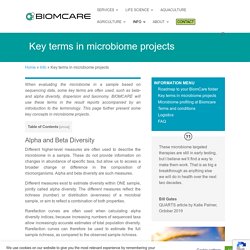
Common forms of dysbiosis in human gut samples are increased levels of Proteobacteria or reduction in diversity. However, often studies are only able to describe a changed microbiome and not to label it dysbiotic as it entails a malfunction not optimal to the host. Normalization Normalization across samples of sequencing data is performed to account for differences in sequencing depths. Rarefaction to even read count This is often performed by subsampling without replacement of the QC’ed set of reads, to a smaller, predetermined and fixed total. Normalization by sample sum An alternative to normalization by rarefaction where a subset and even number of reads are selected form each sample, read counts can be converted to relative frequencies by dividing with the sample sum.
Understand the key terms in microbiome projects. Genetic and microbiome influence on lipid metabolism and dyslipidemia. We're Calling It: Microbiome Skincare Is the Next Big Thing. I don’t know when probiotic skincare came into my consciousness, just like I don’t know when every woman in L.A. and NYC started wearing the same animal-print silk midi skirt.

I only know that one day, both things became ubiquitous on social media feeds. As someone who doesn’t have Instagram, I was getting screenshots of ads for various probiotic skincare lines in my email inbox from friends with a consistent subject line: “Thoughts?” All of a sudden, probiotic skincare became a bandwagon, and I’ve never met a bandwagon I didn’t want to jump on. As I researched in-depth, I learned that this is less of a bandwagon, and more of a movement. I’ve always known about the body’s and gut’s microbiome, but the skin’s microbiome was relatively new to me. Then, last month, I saw a surprising body wash commercial playing on TV at the gym. What are prebiotics, probiotics, and postbiotics? Can you remember the first time you heard about probiotics? 1. 2. Instant Genius: Microbiome. Soil’s Microbial Market Shows the Ruthless Side of Forests.
Beneath the green vegetable world we see is a dark microbial world we don’t.
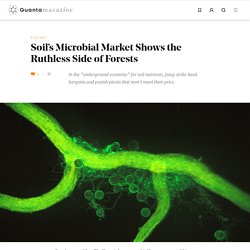
The crops we eat, the forests that sustain us and most other life forms, even the regulation of Earth’s climate — all benefit from a shadowy network of fungi and bacteria that mobilize soil nutrients and trade them with plants for sugars and fats. And yet the workings of this subterranean society are almost unknown to scientists. For example, researchers just mapped for the first time the global distribution of three major groups of these microbes. New ‘reverse genomics’ method brings previously hidden bacteria to life. In the past decade, increasingly powerful genetic techniques have found hordes of microbial DNA in everything from the human gut to a scoop of seawater.
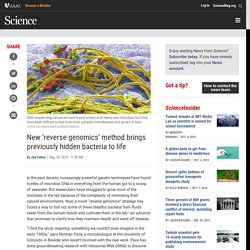
But researchers have struggled to grow most of the microbes in the lab because of the complexity of mimicking their natural environments. Now, a novel “reverse genomics” strategy has found a way to fish out some of these stealthy bacteria from fluids taken from the human mouth and cultivate them in the lab—an advance that promises to clarify how they maintain health and ward off disease. “I find the study inspiring, something we couldn’t even imagine in the early 1980s,” says Norman Pace, a microbiologist at the University of Colorado in Boulder who wasn’t involved with the new work. Our health may be influenced more than we know by soil microbes.
C-section babies show distinct gut microbiome differences. In the largest genomic investigation of baby microbiomes ever conducted researchers have affirmed there are significant differences in gut bacterial diversity between babies born by caesarean and those born vaginally.

While the research adds weight to the evidence suggesting the mode of birth can fundamentally shape a baby’s microbiome, the study notes these bacterial differences mostly even out after 12 months. Microbiome influences gut serotonin and blood sugar levels. Adding to a growing understanding of the role the microbiome plays in our metabolism, a new study from Australian and Canadian researchers has discovered how gut bacteria can directly influence blood sugar levels by promoting the synthesis of gut-derived serotonin.

Serotonin is probably best known as the neurotransmitter that influences feelings of happiness and regulates mood, but the molecule actually has incredibly broad effects across the entire body. In fact, over 90 percent of serotonin produced by a human body is located in the gut. Scientists are only just now learning about the roles these intestinal serotonin secretions play in regulating everything from our gastrointestinal movements, to our general metabolism. As serotonin cannot cross the blood-brain barrier, these intestinal secretions are not thought to directly influence our brain. Instead, gut and blood serotonin levels seem to play a significant role in our overall metabolic profile. Antibiotics impair flu vaccine by disrupting gut bacteria.
A new study is offering the first evidence in humans to suggest depletion of gut microbiome diversity by antibiotics can reduce the efficacy of a vaccination.
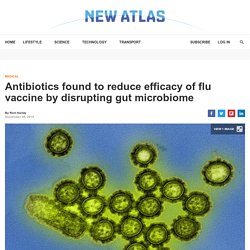
The research focused on a cohort administered with the influenza vaccine, hypothesizing gut bacteria to play a central role in immune response to vaccinations. Last year a team of Australian researchers presented a mouse study finding antibiotics can severely impair an animal’s immune response to vaccinations. That research focused on young mice as proxies for human babies in their first year of life, and specifically examined five vaccines given routinely to infants, including meningitis and whooping cough. Vaccine shows promise against hypervirulent superbug.
Bacteria are fast evolving resistance to antibiotics, and one of the most worrying of these so-called “superbugs” is Klebsiella pneumoniae.
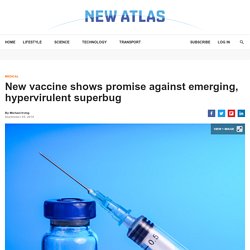
Once largely confined to hospitals, more deadly and drug-resistant forms of the bacteria are now spreading around the world. Thankfully a new vaccine has shown promise against the bug in tests on mice. K. pneumoniae has been a pest in hospitals for years, often infecting patients there for other reasons. It causes some types of pneumonia, as well as infections of the bloodstream and liver, and has developed resistance to many antibiotics, including those considered our last line of defense.
It was only really dangerous in children, the elderly, or those with weakened immune systems – until recently. “For a long time, Klebsiella was primarily an issue in the hospital setting, so even though drug resistance was a real problem in treating these infections, the impact on the public was limited,” says David Rosen, co-author of the new study. Incredible Stanford study discovers thousands of novel proteins produced by human microbiome.
A remarkable new study from scientists at Stanford University has revealed thousands of previously undiscovered small proteins produced by bacteria in the human microbiome.

Almost all of these newly described proteins serve unknown functions in the human body and the researchers suggest their discovery opens up a new frontier for future therapeutic drug development. "It's critically important to understand the interface between human cells and the microbiome," explains Ami Bhatt, senior author on the recently published study. "How do they communicate? The role of gut bacteria in blood pressure. Microbiome: The first 1,000 days.
In the United States and other developed countries, we have seen a shift over the past several decades in the types of illness people struggle with.

Public health campaigns around vaccination, sanitation, and judicious use of antibiotics have largely eradicated many infectious illnesses. As the nature of disease has shifted to inflammatory conditions, we’ve seen a striking increase in allergy and autoimmune conditions such as diabetes, obesity, inflammatory bowel disease, celiac disease, and multiple sclerosis. The microbiome — the varied and teeming colonies of gut bacteria inside of us — may be helping to drive this shift. What is the microbiome? Colonization occurs within the first two years of life. Newly isolated human gut bacterium reveals possible connection to depression. Research team studies the compelling connection between one of NIH's "most wanted" bacteria and mental health. Researchers have established a correlation between depression and a group of neurotransmitter-producing bacteria found in the human gut. The research team from the U.S. Fecal Transplants: "Super-Pooper" Donors Help Treat IBD, Chronic Diarrhea.
Stool transplants from 'super donors' could be a cure-all. New fecal transplant technique successfully treats inflammatory bowel disease. Your Environment Is Cleaner. Your Immune System Has Never Been So Unprepared. Scientists bust myth that our bodies have more bacteria than human cells : Nature News & Comment. Red blood cells dominate our total cell count by number (though not by mass). It's often said that the bacteria and other microbes in our body outnumber our own cells by about ten to one.
That's a myth that should be forgotten, say researchers in Israel and Canada. The ratio between resident microbes and human cells is more likely to be one-to-one, they calculate. A 'reference man' (one who is 70 kilograms, 20–30 years old and 1.7 metres tall) contains on average about 30 trillion human cells and 39 trillion bacteria, say Ron Milo and Ron Sender at the Weizmann Institute of Science in Rehovot, Israel, and Shai Fuchs at the Hospital for Sick Children in Toronto, Canada. Those numbers are approximate — another person might have half as many or twice as many bacteria, for example — but far from the 10:1 ratio commonly assumed. Source: Ref. 1.
15 tips to boost your microbiome. The gut microbiome is a vast community of trillions of bacteria and fungi inhabit every nook and cranny of your gastrointestinal tract, and have a major influence on your metabolism, body weight, propensity to illness, immune system, appetite and mood. These microbes mostly live in your lower intestine (the colon) and outnumber all the other cells in your body put together. Conceptually, we should view them as a newly discovered organ, weighing slightly more than our brains and nearly as vital. There are some organs we can live without, including our spleen, gall bladder, tonsils and appendix, but we wouldn’t survive long without our gut microbes.
Intriguingly, no two microbiomes are the same – we are all unique. And more than ever, we’re finding out just how important these microbes are. Future - Could gut bacteria microbes make you fat? Our guts contain around 100 trillion microbes, collectively known as the gut microbiota. No two people’s microbiomes look exactly the same, and they are a product of what we inherit from our mothers during birth, our diets, environment and lifestyle. It is well established that the gut plays a role in numerous systems in our body, including digestion, hunger and satiety, through multiple mechanisms, but now researchers are starting to uncover the specific differences between the microbiomes of obese and lean people, and develop personalised weight-management treatments based on their findings.
There are hundreds of differences in the human genome that predispose us to obesity, which increases the risk of developing cardiovascular diseases and type 2 diabetes, and is increasing in most countries around the world. You might also like: Some dieters struggle more than others to lose weight, despite following sensible advice, and this may come down to the bacteria in our guts. Stool transplants from 'super donors' could be a cure-all. A systematic review explores the role of non-antibiotic prescription drugs in gut microbiota dysbiosis - Gut Microbiota for Health.
Executive Education at HMS. Healthy gut, healthy heart? Gut bacteria mechanism behind the anti-seizure effects of ketogenic diet uncovered. The ketogenic diet was originally developed a century ago to treat children with severe epilepsy, but how it actually worked was always unclear. Now an exciting and rigorous study from researchers at UCLA suggests the diet can elevate levels of specific gut bacteria that subsequently affect certain neurotransmitters to reduce the risk of seizures. The ketogenic diet was first developed in 1921, after researchers initially set out to understand how fasting was reducing the frequency of seizures in patients with epilepsy.
Since indefinite fasting was not a pragmatic treatment option, it was discovered that similar effects could be generated through a high-fat/low-carbohydrate diet, and so the now infamous ketogenic diet was born. With the development of modern anticonvulsant drugs in the mid-20th century, the ketogenic diet as a treatment for epilepsy slipped into the annals of outdated medical treatments and was rarely utilized unless a particularly severe case arose.
Gut Microbes Could Play a Role in Heart Disease Too. High-fiber foods may boost gut bacteria to control diabetes. Microbes, Not Food Restriction, Could Be The Key to Our Most Effective Treatment For Obesity. Fecal microbiota transplantation produces sustained improvements in cognitive and clinical outcomes. 14 April 2018, Paris, France: A single treatment using an optimized, targeted form of faecal microbiota transplantation (FMT) produces sustained clinical and cognitive improvements, according to the results of a long-term follow-up of patients with liver cirrhosis and hepatic encephalopathy (HE) who had participated in a short-term study. Gut Bacteria Linked to Age Related Conditions - Neuroscience News. Molecular cuisine for gut bacteria. How bacteria are changing your mood. GDPR consent required.
Welcome to Medical News Today Healthline Media, Inc. would like to process and share personal data (e.g., mobile ad id) and data about your use of our site (e.g., content interests) with our third party partners (see a current list) using cookies and similar automatic collection tools in order to a) personalize content and/or offers on our site or other sites, b) communicate with you upon request, and/or c) for additional reasons upon notice and, when applicable, with your consent. Healthline Media, Inc. is based in and operates this site from the United States. Vitals.lifehacker. Does vaginal seeding boost health? Should Caesarean-section babies be smeared with a sample of their mother's vaginal fluids as soon as they are born? "Vaginal seeding" is not mainstream medicine, but it is growing in popularity. The idea is to give these newborns something they missed when they emerged into the world - the good bacteria that live in their mother's vagina.
Nightmare Bacteria: What You Need to Know About Antibiotic-Resistant Germs. The Results of the First American Gut Project Are In. Gut Microbes. 6m Welcome Mark Pimentel, MD, FRCP(C) Microbes. Phil Nast, retired middle school teacher and freelance writer. Gut Microbes. 4 Microbiome Educational Activities for the Classroom. Modeling the Dynamic Digestive System Microbiome<span class="xref"> <span class="jp-sup"> <a href="#fn1-jmbe-16-271">†</a> </span> </span> Abstract: Lesson 5: The human microbiome. Lesson 5: The human microbiome. About the Microbiome. Your Gut Bacteria and Your Health. Discovered Tribe’s Bacteria May Point to Our Past. The findings, published in the journal Science Advances, seem to be part of a pattern. What Is Your Gut Bacteria Telling You? Bacteria and the Gut - Can It Affect The Brain?
This 40 year old antibiotic could fight back against the worst superbugs. The Rise Of Yeast: How Civilization Was Shaped By Sugar Fungi : The Salt. 20,000 Microbes Under the Sea. Cesarean Section and Chronic Immune Disorders. Delivery mode shapes the acquisition and structure of the initial microbiota across multiple body habitats in newborns. Co725. How to feed your gut. Specific gut bacteria can help or hinder cancer treatments. Clogged arteries may be down to bacteria, not diet. Breast cancer: Bacterial deficiency linked with onset. The Link Between Gut Bacteria and Multiple Sclerosis. 'Big Chicken': The Medical Mystery That Traced Back To Slaughterhouse Workers : The Salt. Scientists are turning their attention to the microbiome of where we live. Biohacking Gut Health: A Doctors Tips for a Healthy Microbiome.
Science Is Showing How Gut Bacteria Affect The Brain, But Don't Bother Taking Probiotics Yet. Making an Antoni van Leeuwenhoek microscope Microscope replica. Personalized Nutrition & Gut Microbiome. Towards Psychobiotics: The Microbiome as a Key Regulator of Brain and Behavior. Probiotics and Atopic Dermatitis: An Overview. Do probiotics for eczema work? Human Microbiome Project. Gut microbiome modulates response to anti–PD-1 immunotherapy in melanoma patients.
Gut microbiome influences efficacy of PD-1–based immunotherapy against epithelial tumors. The ‘superantibiotics’ that could save us from bacteria apocalypse. Rethink Healthy Skin. Video: Our Microbiome - Health Matters (30 minutes) Video Series: The Microbiome and Digestion. The Hungry Microbiome: why resistant starch is good for you. Intro Video: The Human Microbiome. Intro Video: You're Not What You Think You Are. The HIDDEN World of Microbiomes. My No-Soap, No-Shampoo, Bacteria-Rich Hygiene Experiment - The New York Times. The Solution for Skin Ailments Could Be Right Under Your Nose - The New York Times. Cookies are Not Accepted - New York Times. גלובס זירת העסקים של ישראל. Log In - New York Times. Log In - New York Times. Improve Clinical Outcomes by Caring for the "Second Brain" Log In. Earth May Be Home to a Trillion Species of Microbes. Barnyard Dust Offers a Clue to Stopping Asthma in Children. חיידקים, נגיפים, ושאר "ירקות" - בלוג של ביולוג - ד"ר דרור בר-ניר: חיידקים פרוביוטיים ביוגורט יפים לבריאות - עם כ-140 גביעים ביום אתם מסודרים...
Scientists discover gut bacteria that influences mood by ‘eating’ brain chemical. The Microbiome Solution - Kale and Chocolate. Microbiota, leaky gut syndrome and gut-related diseases. Probiotics. Brain–Gut–Microbe Communication in Health and Disease. Brain–Gut–Microbe Communication in Health and Disease. שימור מזון – כבישה, התססה.